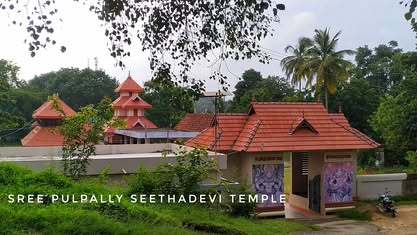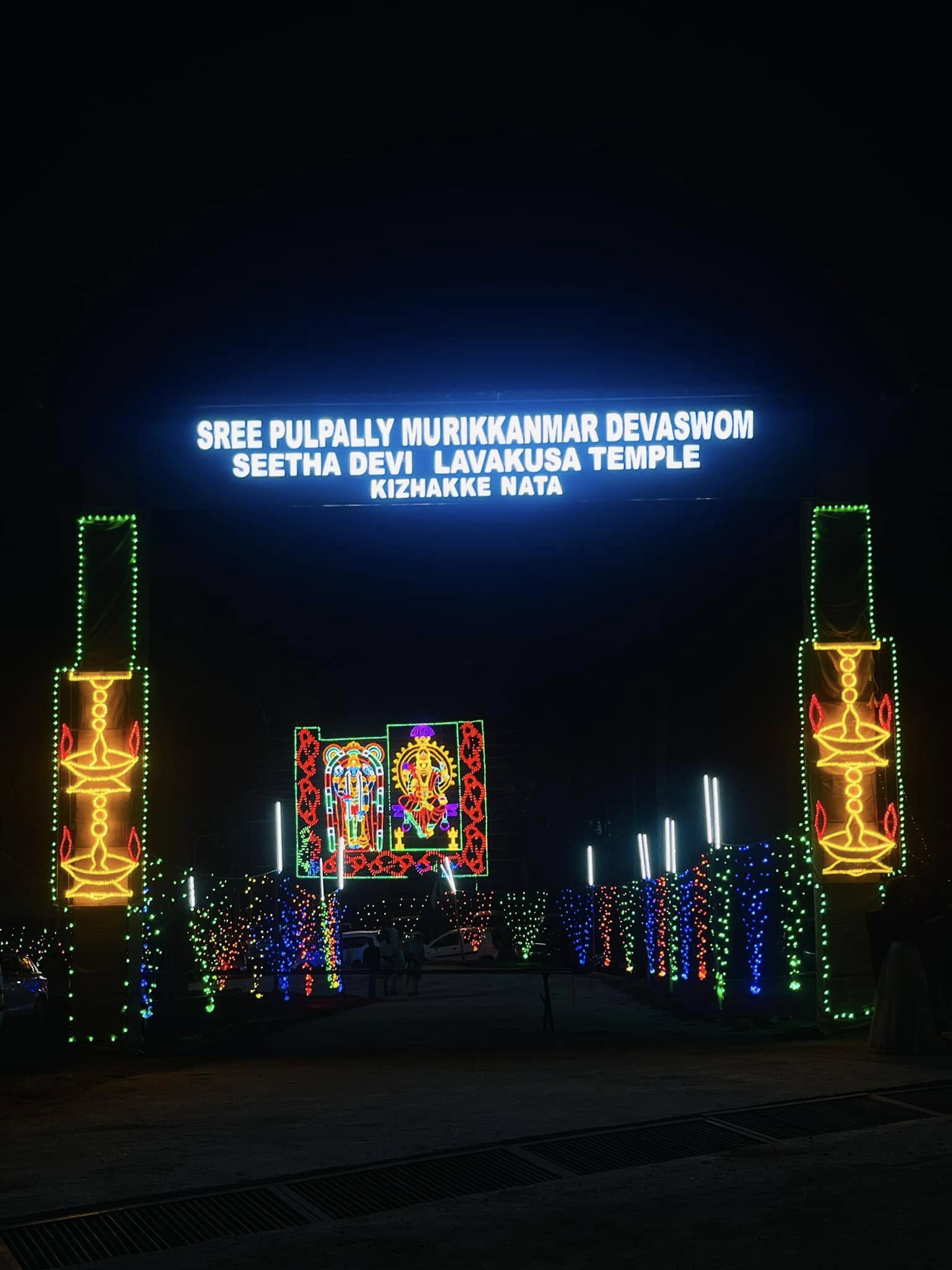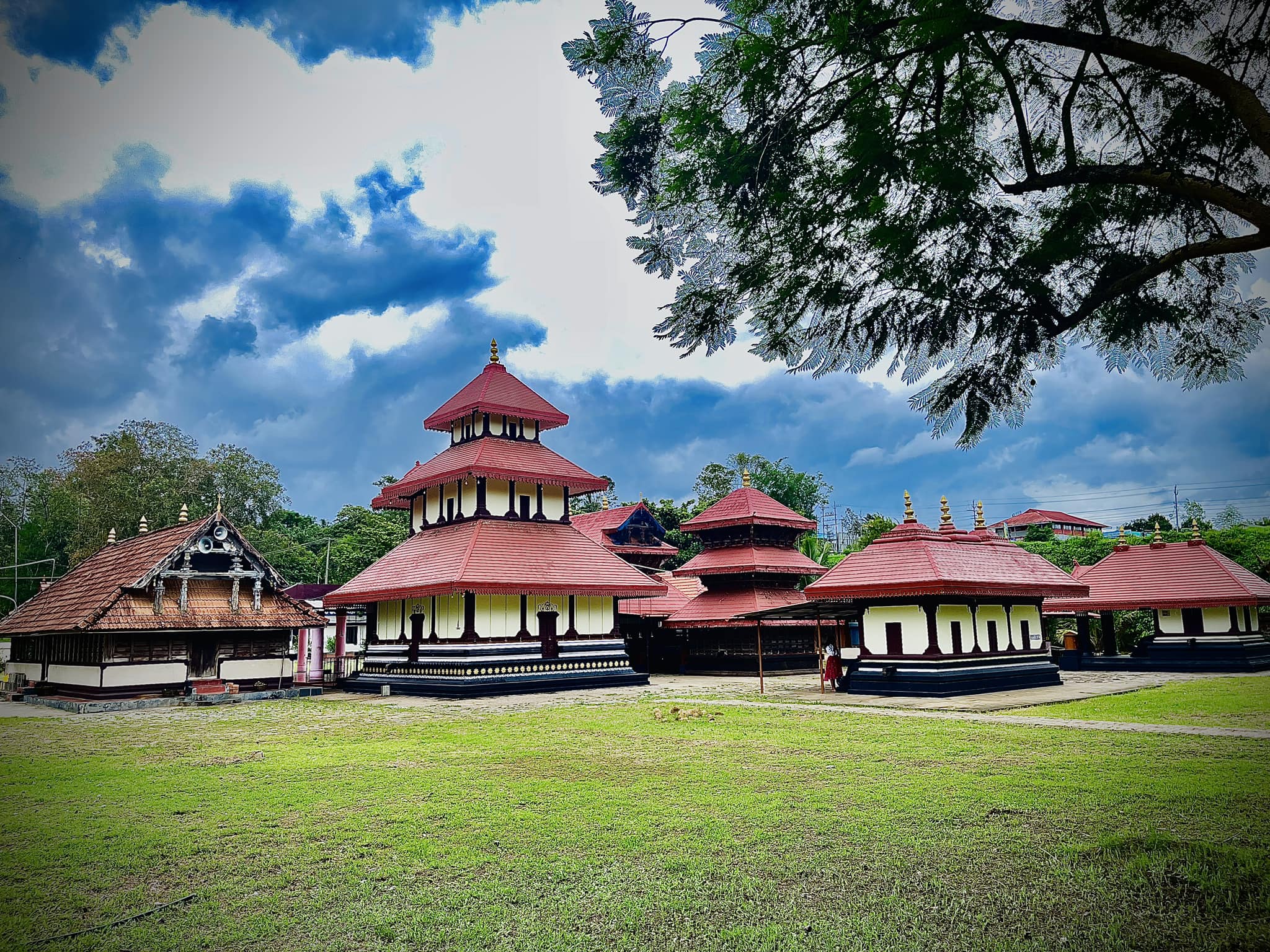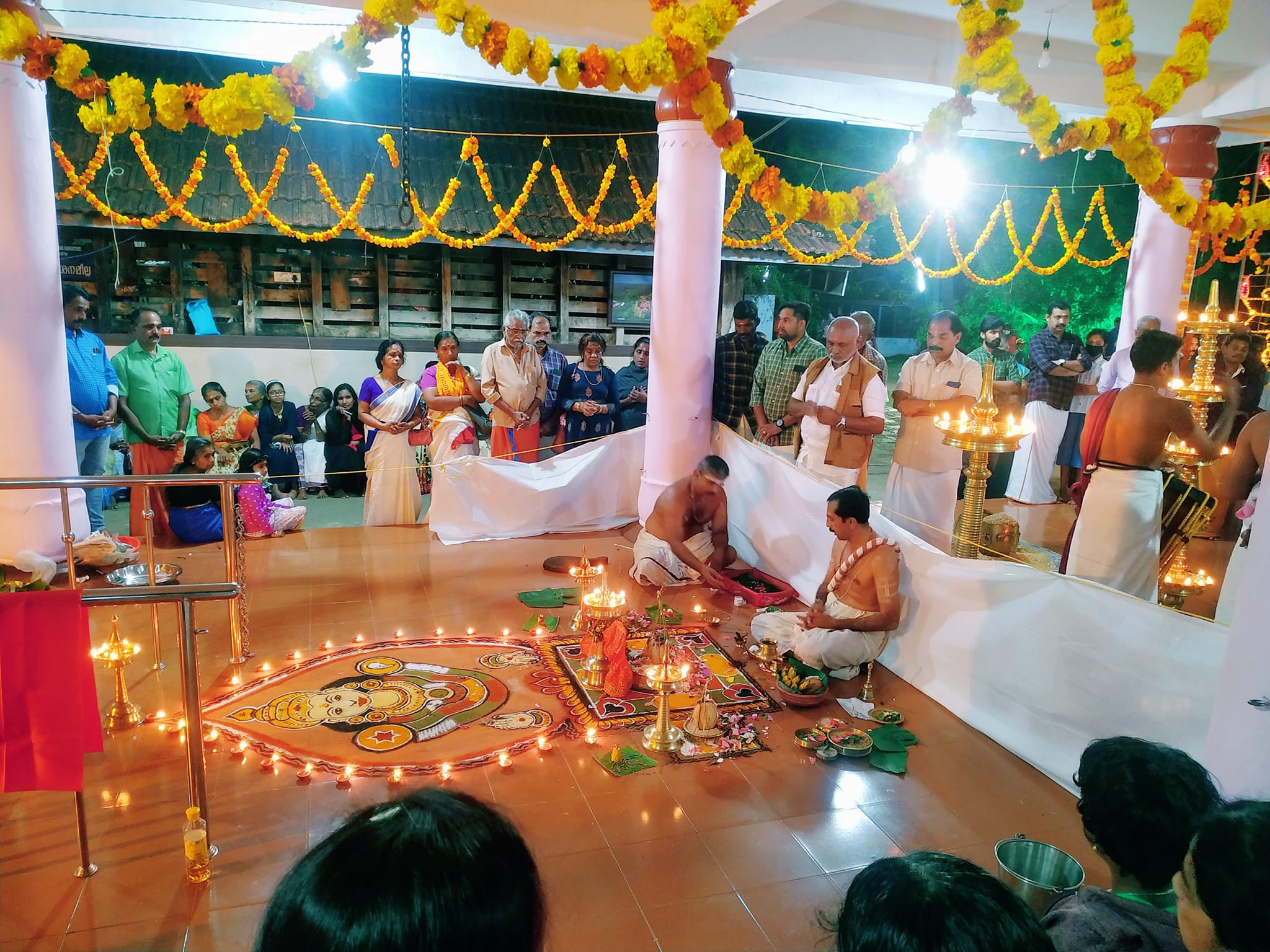Sree Seetha Devi Lava Kusha Temple in Pulpally, Wayanad, holds a unique place among Kerala’s temples and is considered one of the rarest in India.

It is one of the very few temples where the deities of Lava and Kusha—sons of Lord Rama and Seetha Devi—are installed and actively worshipped. The temple is deeply rooted in the legend of Seetha and her sons, and it is believed that the name "Pulpally" itself is derived from the sacred Dharbha grass bed where Lava is said to have played during his childhood.
The temple pond is one of the largest in Wayanad, and the name "Seetha" itself is etymologically linked to the earth, emphasizing the deep connection of this land with the Ramayana. It is believed that when Seetha was abandoned by Lord Rama, she found refuge here under the care of Sage Valmiki. The spot where she gave birth to Lava and Kusha is known as Valmiki Ashramam, which still maintains its traditional ashram-like form. Chedattinkavu, or the Sree Chedattinkaavilamma Seethadevi Temple, is regarded as the original sanctum ('moolasthanam') of the Pulpally temple and is located just 1 km away.
According to legend, during the Ashwamedha Yagna, Lava and Kusha captured the horse sent by Rama. When Rama came to retrieve it, he saw Seetha, who then disappeared into the earth, her divine mother. As she descended, Rama grabbed her hair, leading to the name "Chedattinkavu" (meaning where the hair was caught). The temple is dedicated to Seetha Devi, also known as Chedattilamma, and the Sapthamatrukkal (Seven Mother Goddesses).
The main offering here is Nei Vilakku (ghee lamp). The present Seetha Devi Temple was constructed in the 18th century by the legendary warrior Sri Pazhassi Raja, who also held strategic meetings with his commanders within the temple courtyard. Later, temple management passed to the prominent Kuppathode Nair family, with its chief residing at Nellaratt Edom. Even today, a member of this family serves as the temple trustee. During Tipu Sultan’s invasion of Wayanad, it is believed he was forced to retreat from this site due to sudden divine darkness caused by Seetha Devi’s power.
Another miracle associated with this temple is the complete absence of leeches in its vicinity, unusual for a region like Wayanad. Legend says that Seetha cursed the leeches after they bit Lava and Kusha, banishing them from the area. The presence of numerous termite mounds (Valmeekam) around the site is linked to Sage Valmiki, the author of the Ramayana. The temple festival, celebrated in early January, is the regional festival of Pulpally and draws thousands of devotees from all communities across Wayanad.Several other temples in the region are deeply connected to the central legend of Seetha Devi and her sons, Lava and Kusha.
Ponkuzhi Sita Temple in Muthanga is believed to stand on the very site where Lakshmana abandoned Seetha in the forest, and the nearby lake is said to have formed from her tears. The Sree Valmiki Ashramam at Ashramam Kolli is traditionally considered to be the hermitage where Seetha took refuge and gave birth to her sons; the site preserves a humble, thatched-roof structure and features the Munipara, a large rock where Ratnakaran is believed to have performed the penance that transformed him into Sage Valmiki.
Irulam Sree Seetha Devi Lava-Kusha Temple is said to be the resting spot for Seetha and her children after a day in the forest, where divine guidance from Lord Shiva and Lord Vishnu ensured their protection. At Sisumala, the Seetha Lava-Kusha Temple is located at the place where the young twins once joyfully roamed under their mother’s watchful care—hence the name 'Sisumala', meaning 'children’s hill' in Malayalam.
പുൽപ്പള്ളി സീതാദേവി ക്ഷേത്രം
വയനാട് ജില്ലയിലെ പുൽപ്പള്ളി പഞ്ചായത്തിൽ സ്ഥിതിചെയ്യുന്ന സീതാദേവി-ലവ-കുശ ക്ഷേത്രം ഒരു അപൂർവക്ഷേത്രമാണ്. കേരളത്തിലൊട്ടാകെ സീതാദേവിയും പുത്രന്മാരായ ലവനും കുശനും പ്രധാന പ്രതിഷ്ഠകളായി പൂജിക്കപ്പെടുന്ന കുറച്ച് ക്ഷേത്രങ്ങളിൽ ഒന്നാണ് ഇത്. സീതാ രാമായണത്തിലെ മുഖ്യനായികയും മഹാലക്ഷ്മിയുടെ അവതാരവുമാണ് എന്ന വിശ്വാസമുണ്ട്. പുൽപ്പള്ളിയും അതിന്റെ ചുറ്റുമുള്ള പ്രദേശങ്ങളും രാമായണത്തിലെ സംഭവങ്ങളുമായി ചേർന്ന് നിരവധി ദൈവിക കഥകൾക്കായി പ്രസിദ്ധമാണ്. വിശ്വാസപ്രകാരം, ത്രേതായുഗത്തിൽ ശ്രീരാമൻ ഉപേക്ഷിച്ച സീതാ ദേവി ഇവിടെ എത്തിച്ചേർന്നു, പിന്നീട് വാല്മീകി മഹർഷിയുടെ ആശ്രമത്തിൽ ലവനും കുശനും ജനിച്ചു.
ഇന്നു ആശ്രമക്കൊല്ലിയെന്ന സ്ഥലത്ത് വാല്മീകി ആശ്രമം പ്രകൃതിസൗന്ദര്യത്തോടെ നിലനിൽക്കുന്നുണ്ട്. ഈ ക്ഷേത്രം ഒരു കാലത്ത് കോട്ടയം രാജവംശത്തിന്റേയും പിന്നീട് മലബാർ ദേവസ്വം ബോർഡിൻ്റെയും കീഴിലായിരുന്നു. ഒരുകാലത്ത് ക്ഷേത്രത്തിന് ഏകദേശം 22000 ഏക്കർ ഭൂമിയുണ്ടായിരുന്നതായും, വീരകേരളവർമ്മ പഴശ്ശിരാജയുടെ വീരചരമത്തിനു ശേഷം ബ്രിട്ടീഷുകാരിൽ നിന്നും ഭരണം ഏറ്റെടുത്തവർ ഭൂരഹിതമാക്കിയതോടെ ക്ഷേത്രത്തിന്റെ ഭൂമി 31 ഏക്കറായി ചുരുങ്ങിയതായും ചരിത്രത്തിൽ രേഖപെടുത്തിയിരിക്കുന്നു.ക്ഷേത്ര മുറ്റത്തുവച്ച് ധീരനായ ദേശാഭിമാനി പഴശ്ശിരാജ, 5000 തോളോളം പടയാളികളുമായി ശ്രീപോർക്കളി ഭഗവതിയെ വണങ്ങി പൂജിച്ചു, അതിനുശേഷമാണ് അദ്ദേഹം ബ്രിട്ടീഷുകാരോടുള്ള യുദ്ധത്തിനിറങ്ങിയത്.
പുൽപ്പള്ളി പ്രദേശം സീതാദേവിയുടെ കാനനവാസകഥകളുമായി ചേർന്ന് നിറഞ്ഞു നിൽക്കുന്ന വിശ്വാസകേന്ദ്രമാണ്. അതിനാൽ, ചെട്ടിമാർ, ചില നായർ കുടുംബങ്ങൾ എന്നിവർക്കും സീതാദേവി തറവാട്ടു ദേവതയായി ആരാധിക്കപ്പെടുന്നു. പുൽപ്പള്ളി പട്ടണത്തിനടുത്ത് സ്ഥിതിചെയ്യുന്ന ജഡയറ്റ് കാവ് എന്നത് പുൽപ്പള്ളി സീതാദേവി-ലവ-കുശ ക്ഷേത്രത്തോടൊപ്പം ബന്ധപ്പെട്ട മറ്റൊരു ദിവ്യസ്ഥാനമാണ്. ഇതിനെ മൂലക്ഷേത്രം എന്നും വിശ്വാസികൾ കണക്കാക്കുന്നു.
രാമായണത്തിലെ അത്യന്തം ദുഃഖഭരിതമായ രംഗമായ സീതാദേവിയുടെ ഭൂപ്രവേശം സംഭവിച്ചതായി കരുതപ്പെടുന്ന സ്ഥലമാണിത്. ശ്രീരാമനും ലക്ഷ്മണനും മക്കളായ ലവനും കുശനും സാക്ഷികളായി സീതാദേവി ഭൂമിയിലേക്ക് അന്തർദ്ധാനം ചെയ്തുവെന്ന് ജനവിശ്വാസമുണ്ട്.
ജഡയറ്റ്കാവിൽ ഇപ്പോഴും പുരാതനരീതിയിൽ നിത്യപൂജകൾ നടക്കുന്നു. ക്ഷേത്രത്തിൽ സപ്തമാതൃക്കകൾക്കും സീതാദേവിക്കും സമർപ്പിച്ച രണ്ട് ശ്രീകോവിലുകളുണ്ട്. കൂടാതെ, ദേവിയുടെ അന്തർദ്ധാനസ്ഥലത്ത് ക്ഷേത്ര പുനരുദ്ധാരണത്തിന്റെ ഭാഗമായി ശിലയിൽ തീർത്ത സഹസ്രദളപത്മം (1000 അണ്ടുകൾ ഉള്ള കമലം) സ്ഥാപിച്ചിരിക്കുന്നു.
Address:
Pulpally, Kerala 673579



